A Primary Health Care Program for Combating Alcoholism in Australia
VerifiedAdded on 2023/06/12
|11
|2978
|362
Report
AI Summary
This report outlines a comprehensive primary health care (PHC) program designed to combat excessive alcoholism in Australia, addressing its devastating effects on families, communities, and the nation. It begins by defining Australia's PHC framework, emphasizing its role as the entry point into the healthcare system for various populations and health conditions. The report highlights the significance of alcoholism as a PHC priority, referencing national surveys indicating high rates of alcohol misuse, especially among young adults and pregnant women. The proposed program involves a needs assessment, goal setting, and the implementation of evidence-based interventions, drawing from social network theory, social cognitive theory, and the ecological model. Key activities include health promotion through media and literacy programs, life skills training in schools, stricter policy regulations on alcohol sales, and rehabilitation programs for addicts. The evaluation framework focuses on assessing the program's success against set guidelines and objectives, utilizing formative, process, impact, and outcome evaluations underpinned by the health belief model.
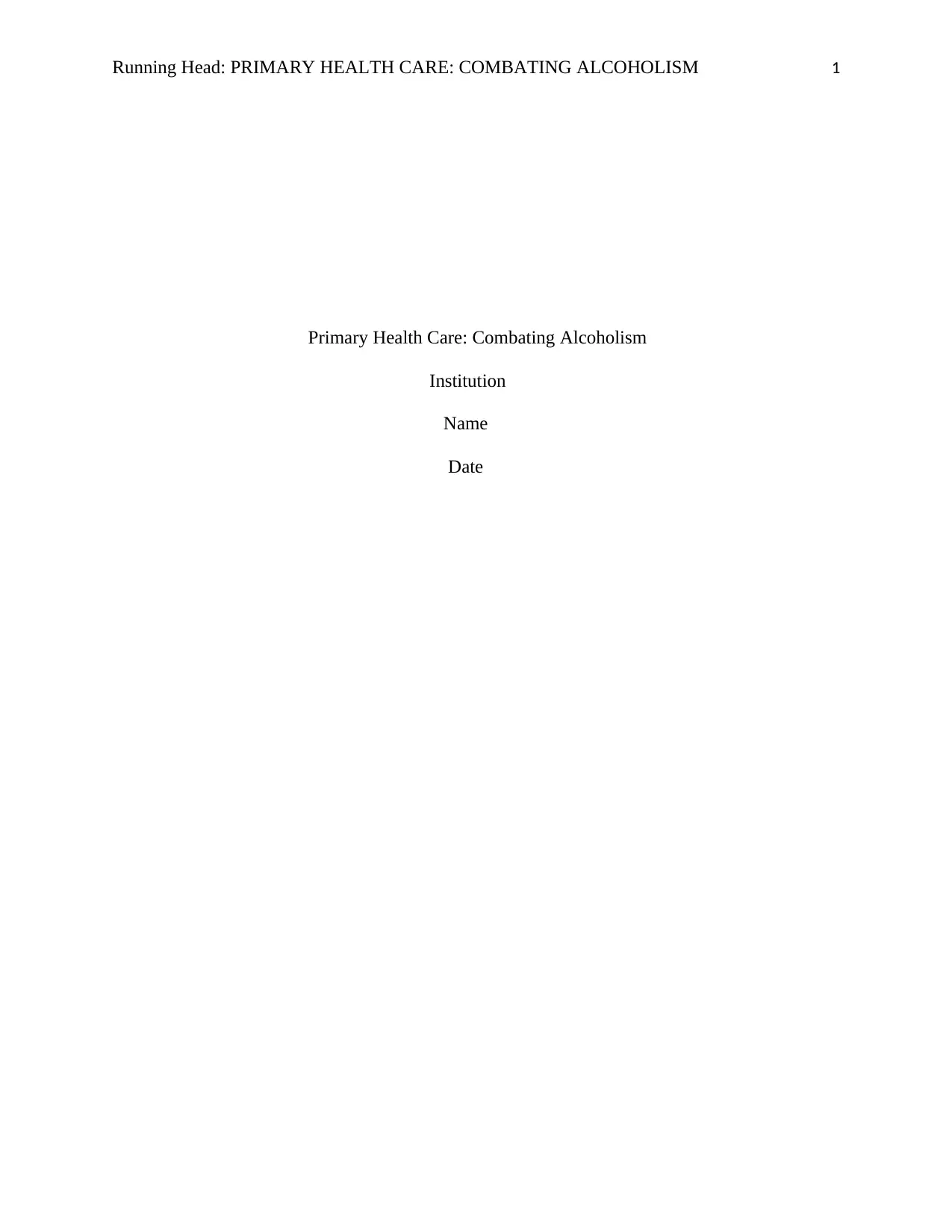
Running Head: PRIMARY HEALTH CARE: COMBATING ALCOHOLISM 1
Primary Health Care: Combating Alcoholism
Institution
Name
Date
Primary Health Care: Combating Alcoholism
Institution
Name
Date
Paraphrase This Document
Need a fresh take? Get an instant paraphrase of this document with our AI Paraphraser
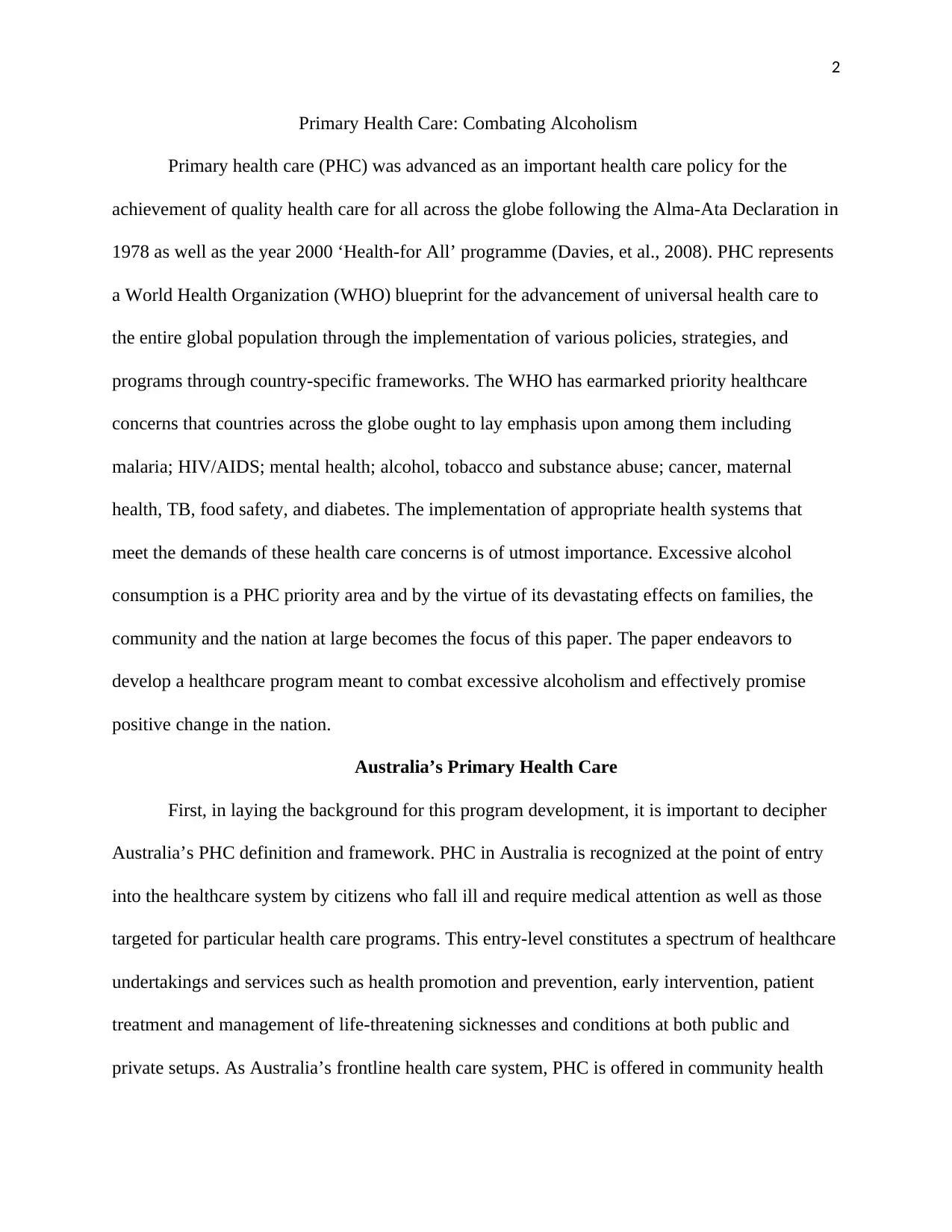
2
Primary Health Care: Combating Alcoholism
Primary health care (PHC) was advanced as an important health care policy for the
achievement of quality health care for all across the globe following the Alma-Ata Declaration in
1978 as well as the year 2000 ‘Health-for All’ programme (Davies, et al., 2008). PHC represents
a World Health Organization (WHO) blueprint for the advancement of universal health care to
the entire global population through the implementation of various policies, strategies, and
programs through country-specific frameworks. The WHO has earmarked priority healthcare
concerns that countries across the globe ought to lay emphasis upon among them including
malaria; HIV/AIDS; mental health; alcohol, tobacco and substance abuse; cancer, maternal
health, TB, food safety, and diabetes. The implementation of appropriate health systems that
meet the demands of these health care concerns is of utmost importance. Excessive alcohol
consumption is a PHC priority area and by the virtue of its devastating effects on families, the
community and the nation at large becomes the focus of this paper. The paper endeavors to
develop a healthcare program meant to combat excessive alcoholism and effectively promise
positive change in the nation.
Australia’s Primary Health Care
First, in laying the background for this program development, it is important to decipher
Australia’s PHC definition and framework. PHC in Australia is recognized at the point of entry
into the healthcare system by citizens who fall ill and require medical attention as well as those
targeted for particular health care programs. This entry-level constitutes a spectrum of healthcare
undertakings and services such as health promotion and prevention, early intervention, patient
treatment and management of life-threatening sicknesses and conditions at both public and
private setups. As Australia’s frontline health care system, PHC is offered in community health
Primary Health Care: Combating Alcoholism
Primary health care (PHC) was advanced as an important health care policy for the
achievement of quality health care for all across the globe following the Alma-Ata Declaration in
1978 as well as the year 2000 ‘Health-for All’ programme (Davies, et al., 2008). PHC represents
a World Health Organization (WHO) blueprint for the advancement of universal health care to
the entire global population through the implementation of various policies, strategies, and
programs through country-specific frameworks. The WHO has earmarked priority healthcare
concerns that countries across the globe ought to lay emphasis upon among them including
malaria; HIV/AIDS; mental health; alcohol, tobacco and substance abuse; cancer, maternal
health, TB, food safety, and diabetes. The implementation of appropriate health systems that
meet the demands of these health care concerns is of utmost importance. Excessive alcohol
consumption is a PHC priority area and by the virtue of its devastating effects on families, the
community and the nation at large becomes the focus of this paper. The paper endeavors to
develop a healthcare program meant to combat excessive alcoholism and effectively promise
positive change in the nation.
Australia’s Primary Health Care
First, in laying the background for this program development, it is important to decipher
Australia’s PHC definition and framework. PHC in Australia is recognized at the point of entry
into the healthcare system by citizens who fall ill and require medical attention as well as those
targeted for particular health care programs. This entry-level constitutes a spectrum of healthcare
undertakings and services such as health promotion and prevention, early intervention, patient
treatment and management of life-threatening sicknesses and conditions at both public and
private setups. As Australia’s frontline health care system, PHC is offered in community health
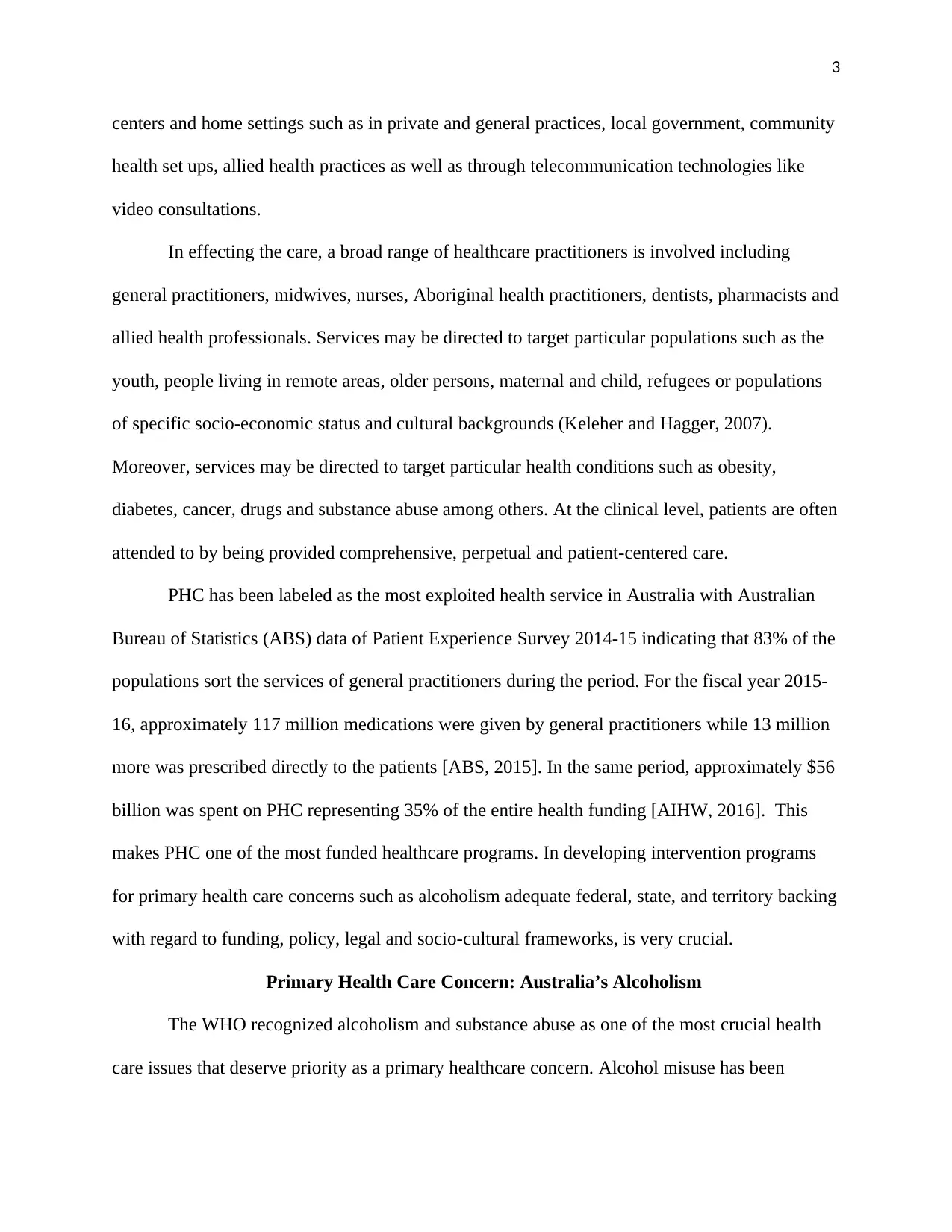
3
centers and home settings such as in private and general practices, local government, community
health set ups, allied health practices as well as through telecommunication technologies like
video consultations.
In effecting the care, a broad range of healthcare practitioners is involved including
general practitioners, midwives, nurses, Aboriginal health practitioners, dentists, pharmacists and
allied health professionals. Services may be directed to target particular populations such as the
youth, people living in remote areas, older persons, maternal and child, refugees or populations
of specific socio-economic status and cultural backgrounds (Keleher and Hagger, 2007).
Moreover, services may be directed to target particular health conditions such as obesity,
diabetes, cancer, drugs and substance abuse among others. At the clinical level, patients are often
attended to by being provided comprehensive, perpetual and patient-centered care.
PHC has been labeled as the most exploited health service in Australia with Australian
Bureau of Statistics (ABS) data of Patient Experience Survey 2014-15 indicating that 83% of the
populations sort the services of general practitioners during the period. For the fiscal year 2015-
16, approximately 117 million medications were given by general practitioners while 13 million
more was prescribed directly to the patients [ABS, 2015]. In the same period, approximately $56
billion was spent on PHC representing 35% of the entire health funding [AIHW, 2016]. This
makes PHC one of the most funded healthcare programs. In developing intervention programs
for primary health care concerns such as alcoholism adequate federal, state, and territory backing
with regard to funding, policy, legal and socio-cultural frameworks, is very crucial.
Primary Health Care Concern: Australia’s Alcoholism
The WHO recognized alcoholism and substance abuse as one of the most crucial health
care issues that deserve priority as a primary healthcare concern. Alcohol misuse has been
centers and home settings such as in private and general practices, local government, community
health set ups, allied health practices as well as through telecommunication technologies like
video consultations.
In effecting the care, a broad range of healthcare practitioners is involved including
general practitioners, midwives, nurses, Aboriginal health practitioners, dentists, pharmacists and
allied health professionals. Services may be directed to target particular populations such as the
youth, people living in remote areas, older persons, maternal and child, refugees or populations
of specific socio-economic status and cultural backgrounds (Keleher and Hagger, 2007).
Moreover, services may be directed to target particular health conditions such as obesity,
diabetes, cancer, drugs and substance abuse among others. At the clinical level, patients are often
attended to by being provided comprehensive, perpetual and patient-centered care.
PHC has been labeled as the most exploited health service in Australia with Australian
Bureau of Statistics (ABS) data of Patient Experience Survey 2014-15 indicating that 83% of the
populations sort the services of general practitioners during the period. For the fiscal year 2015-
16, approximately 117 million medications were given by general practitioners while 13 million
more was prescribed directly to the patients [ABS, 2015]. In the same period, approximately $56
billion was spent on PHC representing 35% of the entire health funding [AIHW, 2016]. This
makes PHC one of the most funded healthcare programs. In developing intervention programs
for primary health care concerns such as alcoholism adequate federal, state, and territory backing
with regard to funding, policy, legal and socio-cultural frameworks, is very crucial.
Primary Health Care Concern: Australia’s Alcoholism
The WHO recognized alcoholism and substance abuse as one of the most crucial health
care issues that deserve priority as a primary healthcare concern. Alcohol misuse has been
⊘ This is a preview!⊘
Do you want full access?
Subscribe today to unlock all pages.

Trusted by 1+ million students worldwide

4
singled out as a costly health care issue with abilities to devastating the society dearly. Deehan,
Marshall, and Strang (1998) contend that PHC can be instrumental in laying programs that can
help promote and advocate for the prevention of alcoholism, reduce the general alcohol
consumption rates as well as treat alcohol addicts who have already contracted mental illnesses.
Australia's National Survey of Mental Health and Wellbeing (NSMHWB) indicate that one in
every four Australian’s between ages 16 and 24 have been reported to experience mental
disorder which can be attributed directly to alcohol consumption (Reavley et al., 2010).
The National Drug Strategy Household Survey (AIHW 2008) showed that majority of
Australians adults have experienced alcohol and a significant number continue to drink in most
times of their lives. The survey indicated that approximately 90% have tried drinking alcohol
during their lifetime while approximately 83% are bound to consume alcohol in any given year.
Windle (2004) observed massive alcohol misuse among adolescence in which alcohol
consumption became more common with increased age. Moreover, Windle (2004) found out that
though older adults tend to take less alcohol than their junior counterparts; their likelihood of
consuming every day is high. Furthermore, the research showcased that the number of pregnant
women engaging in excessive alcohol consumption is on the rise. Colvin et al (2007) indicated
that 59% of Australian women are likely to drink at a certain time during pregnancy. With regard
to the Australian workforce, Berry et al., (2007) deduced that 44% of the total Australian
workforce could be active alcohol drinkers with the majority of them being relatively young
workers and those working in blue-collar occupations.
Primary Health Care Program for Combating Alcoholism
Against the foregoing background on what constitutes comprehensive primary health care
provision and the current stance in Australia's national alcohol abuse, a formidable healthcare
singled out as a costly health care issue with abilities to devastating the society dearly. Deehan,
Marshall, and Strang (1998) contend that PHC can be instrumental in laying programs that can
help promote and advocate for the prevention of alcoholism, reduce the general alcohol
consumption rates as well as treat alcohol addicts who have already contracted mental illnesses.
Australia's National Survey of Mental Health and Wellbeing (NSMHWB) indicate that one in
every four Australian’s between ages 16 and 24 have been reported to experience mental
disorder which can be attributed directly to alcohol consumption (Reavley et al., 2010).
The National Drug Strategy Household Survey (AIHW 2008) showed that majority of
Australians adults have experienced alcohol and a significant number continue to drink in most
times of their lives. The survey indicated that approximately 90% have tried drinking alcohol
during their lifetime while approximately 83% are bound to consume alcohol in any given year.
Windle (2004) observed massive alcohol misuse among adolescence in which alcohol
consumption became more common with increased age. Moreover, Windle (2004) found out that
though older adults tend to take less alcohol than their junior counterparts; their likelihood of
consuming every day is high. Furthermore, the research showcased that the number of pregnant
women engaging in excessive alcohol consumption is on the rise. Colvin et al (2007) indicated
that 59% of Australian women are likely to drink at a certain time during pregnancy. With regard
to the Australian workforce, Berry et al., (2007) deduced that 44% of the total Australian
workforce could be active alcohol drinkers with the majority of them being relatively young
workers and those working in blue-collar occupations.
Primary Health Care Program for Combating Alcoholism
Against the foregoing background on what constitutes comprehensive primary health care
provision and the current stance in Australia's national alcohol abuse, a formidable healthcare
Paraphrase This Document
Need a fresh take? Get an instant paraphrase of this document with our AI Paraphraser
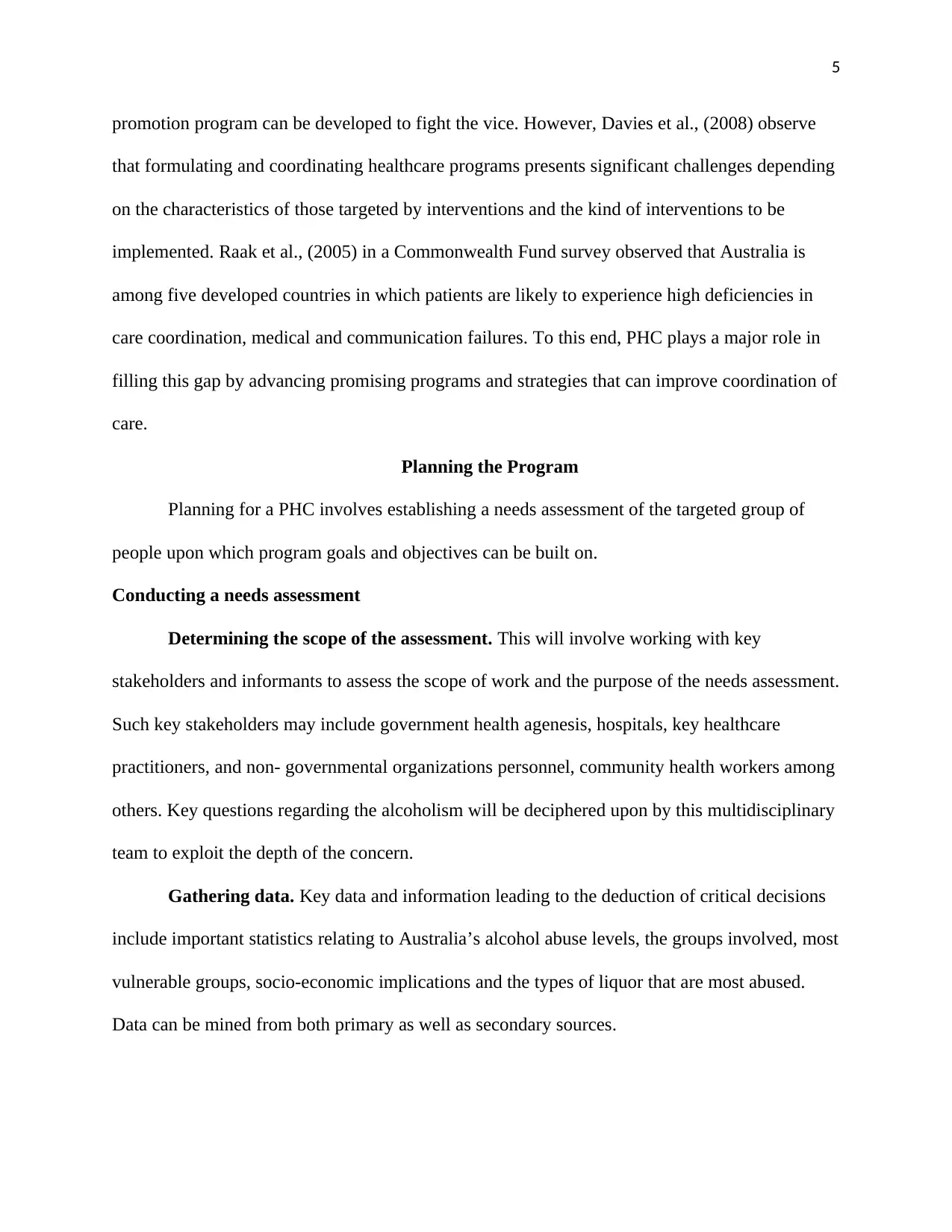
5
promotion program can be developed to fight the vice. However, Davies et al., (2008) observe
that formulating and coordinating healthcare programs presents significant challenges depending
on the characteristics of those targeted by interventions and the kind of interventions to be
implemented. Raak et al., (2005) in a Commonwealth Fund survey observed that Australia is
among five developed countries in which patients are likely to experience high deficiencies in
care coordination, medical and communication failures. To this end, PHC plays a major role in
filling this gap by advancing promising programs and strategies that can improve coordination of
care.
Planning the Program
Planning for a PHC involves establishing a needs assessment of the targeted group of
people upon which program goals and objectives can be built on.
Conducting a needs assessment
Determining the scope of the assessment. This will involve working with key
stakeholders and informants to assess the scope of work and the purpose of the needs assessment.
Such key stakeholders may include government health agenesis, hospitals, key healthcare
practitioners, and non- governmental organizations personnel, community health workers among
others. Key questions regarding the alcoholism will be deciphered upon by this multidisciplinary
team to exploit the depth of the concern.
Gathering data. Key data and information leading to the deduction of critical decisions
include important statistics relating to Australia’s alcohol abuse levels, the groups involved, most
vulnerable groups, socio-economic implications and the types of liquor that are most abused.
Data can be mined from both primary as well as secondary sources.
promotion program can be developed to fight the vice. However, Davies et al., (2008) observe
that formulating and coordinating healthcare programs presents significant challenges depending
on the characteristics of those targeted by interventions and the kind of interventions to be
implemented. Raak et al., (2005) in a Commonwealth Fund survey observed that Australia is
among five developed countries in which patients are likely to experience high deficiencies in
care coordination, medical and communication failures. To this end, PHC plays a major role in
filling this gap by advancing promising programs and strategies that can improve coordination of
care.
Planning the Program
Planning for a PHC involves establishing a needs assessment of the targeted group of
people upon which program goals and objectives can be built on.
Conducting a needs assessment
Determining the scope of the assessment. This will involve working with key
stakeholders and informants to assess the scope of work and the purpose of the needs assessment.
Such key stakeholders may include government health agenesis, hospitals, key healthcare
practitioners, and non- governmental organizations personnel, community health workers among
others. Key questions regarding the alcoholism will be deciphered upon by this multidisciplinary
team to exploit the depth of the concern.
Gathering data. Key data and information leading to the deduction of critical decisions
include important statistics relating to Australia’s alcohol abuse levels, the groups involved, most
vulnerable groups, socio-economic implications and the types of liquor that are most abused.
Data can be mined from both primary as well as secondary sources.

6
Analyzing the data. Data analysis will majorly be descriptive where discussions and
decisions on priorities areas of the program will be advanced by the assessment team. However,
quantitative analysis will be conducted to establish relationships between different data facets
and conclusions deduced if necessary. Data may be grouped to reflect the level of severity,
various behavior risk factors as well as non-behavior risk factors such as social, environmental
and physical factors.
Reporting findings to inform implementation. A comprehensive report will inform the
aftermath of this planning exercise. The report will effectively constitute the blueprint of the
implementation of the interventions needed to avert alcoholism in Australia. In publishing the
report, specific brochures will be produced targeting specific groups of stakeholders and
individuals. Moreover, the report will be posted on the Web besides informing key stakeholders
of its existences through board and staff meetings, e-mails, social and mainstream media.
Goals & Objectives
The goal of the program will read;
“A goal of the National Health and Medical Research Council’s (NHMRC) freedom from
alcoholism is to minimize the number of new alcohol drinkers and helping those who are
already ardent drinkers to stop drinking”
The objectives following this goal will include;
Action (or behavioral) objective
“At the tail end of the program, three-quarters of the targeted populations will
significantly minimize their alcohol consumption and fewer new entrants into alcoholism
will be recorded”
Outcome objective
Analyzing the data. Data analysis will majorly be descriptive where discussions and
decisions on priorities areas of the program will be advanced by the assessment team. However,
quantitative analysis will be conducted to establish relationships between different data facets
and conclusions deduced if necessary. Data may be grouped to reflect the level of severity,
various behavior risk factors as well as non-behavior risk factors such as social, environmental
and physical factors.
Reporting findings to inform implementation. A comprehensive report will inform the
aftermath of this planning exercise. The report will effectively constitute the blueprint of the
implementation of the interventions needed to avert alcoholism in Australia. In publishing the
report, specific brochures will be produced targeting specific groups of stakeholders and
individuals. Moreover, the report will be posted on the Web besides informing key stakeholders
of its existences through board and staff meetings, e-mails, social and mainstream media.
Goals & Objectives
The goal of the program will read;
“A goal of the National Health and Medical Research Council’s (NHMRC) freedom from
alcoholism is to minimize the number of new alcohol drinkers and helping those who are
already ardent drinkers to stop drinking”
The objectives following this goal will include;
Action (or behavioral) objective
“At the tail end of the program, three-quarters of the targeted populations will
significantly minimize their alcohol consumption and fewer new entrants into alcoholism
will be recorded”
Outcome objective
⊘ This is a preview!⊘
Do you want full access?
Subscribe today to unlock all pages.

Trusted by 1+ million students worldwide
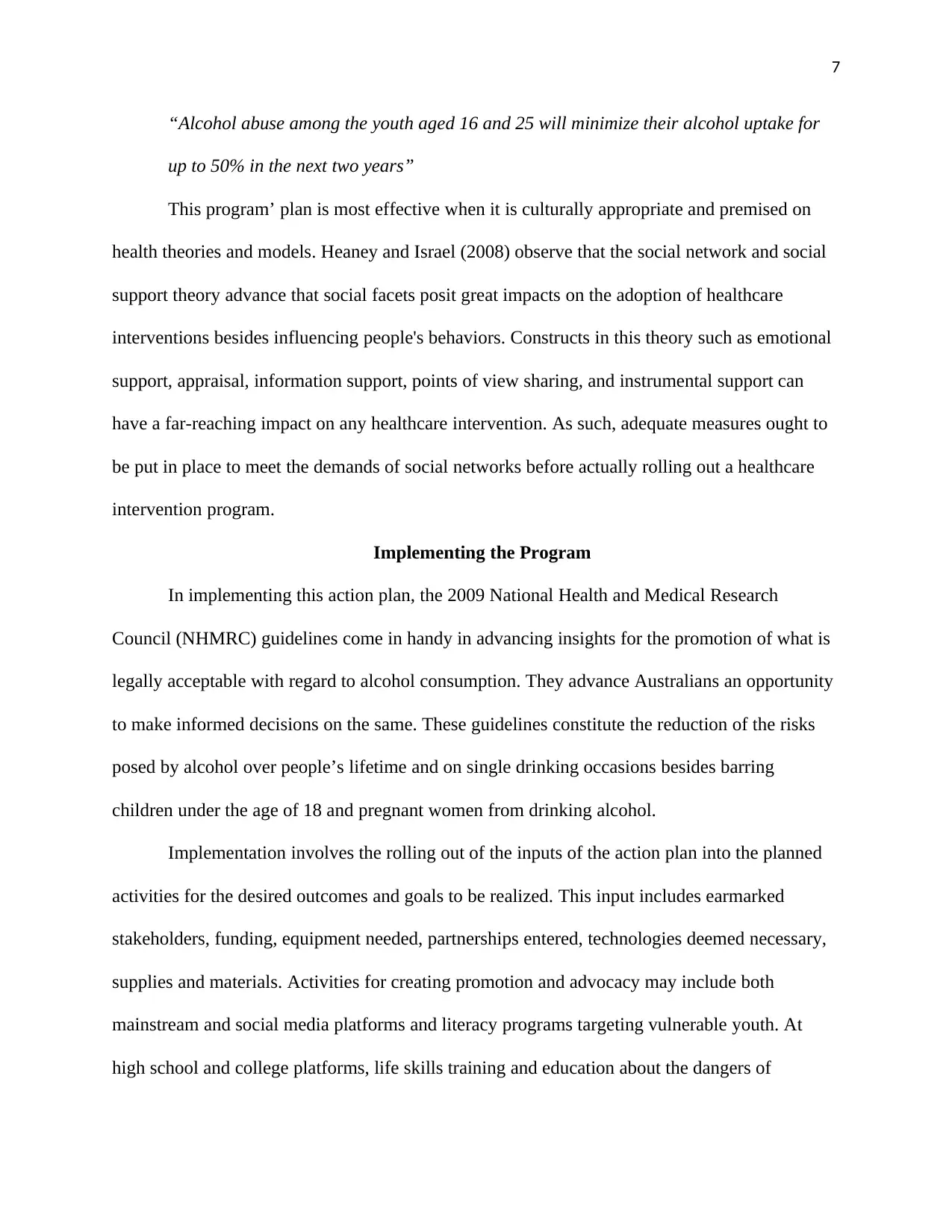
7
“Alcohol abuse among the youth aged 16 and 25 will minimize their alcohol uptake for
up to 50% in the next two years”
This program’ plan is most effective when it is culturally appropriate and premised on
health theories and models. Heaney and Israel (2008) observe that the social network and social
support theory advance that social facets posit great impacts on the adoption of healthcare
interventions besides influencing people's behaviors. Constructs in this theory such as emotional
support, appraisal, information support, points of view sharing, and instrumental support can
have a far-reaching impact on any healthcare intervention. As such, adequate measures ought to
be put in place to meet the demands of social networks before actually rolling out a healthcare
intervention program.
Implementing the Program
In implementing this action plan, the 2009 National Health and Medical Research
Council (NHMRC) guidelines come in handy in advancing insights for the promotion of what is
legally acceptable with regard to alcohol consumption. They advance Australians an opportunity
to make informed decisions on the same. These guidelines constitute the reduction of the risks
posed by alcohol over people’s lifetime and on single drinking occasions besides barring
children under the age of 18 and pregnant women from drinking alcohol.
Implementation involves the rolling out of the inputs of the action plan into the planned
activities for the desired outcomes and goals to be realized. This input includes earmarked
stakeholders, funding, equipment needed, partnerships entered, technologies deemed necessary,
supplies and materials. Activities for creating promotion and advocacy may include both
mainstream and social media platforms and literacy programs targeting vulnerable youth. At
high school and college platforms, life skills training and education about the dangers of
“Alcohol abuse among the youth aged 16 and 25 will minimize their alcohol uptake for
up to 50% in the next two years”
This program’ plan is most effective when it is culturally appropriate and premised on
health theories and models. Heaney and Israel (2008) observe that the social network and social
support theory advance that social facets posit great impacts on the adoption of healthcare
interventions besides influencing people's behaviors. Constructs in this theory such as emotional
support, appraisal, information support, points of view sharing, and instrumental support can
have a far-reaching impact on any healthcare intervention. As such, adequate measures ought to
be put in place to meet the demands of social networks before actually rolling out a healthcare
intervention program.
Implementing the Program
In implementing this action plan, the 2009 National Health and Medical Research
Council (NHMRC) guidelines come in handy in advancing insights for the promotion of what is
legally acceptable with regard to alcohol consumption. They advance Australians an opportunity
to make informed decisions on the same. These guidelines constitute the reduction of the risks
posed by alcohol over people’s lifetime and on single drinking occasions besides barring
children under the age of 18 and pregnant women from drinking alcohol.
Implementation involves the rolling out of the inputs of the action plan into the planned
activities for the desired outcomes and goals to be realized. This input includes earmarked
stakeholders, funding, equipment needed, partnerships entered, technologies deemed necessary,
supplies and materials. Activities for creating promotion and advocacy may include both
mainstream and social media platforms and literacy programs targeting vulnerable youth. At
high school and college platforms, life skills training and education about the dangers of
Paraphrase This Document
Need a fresh take? Get an instant paraphrase of this document with our AI Paraphraser
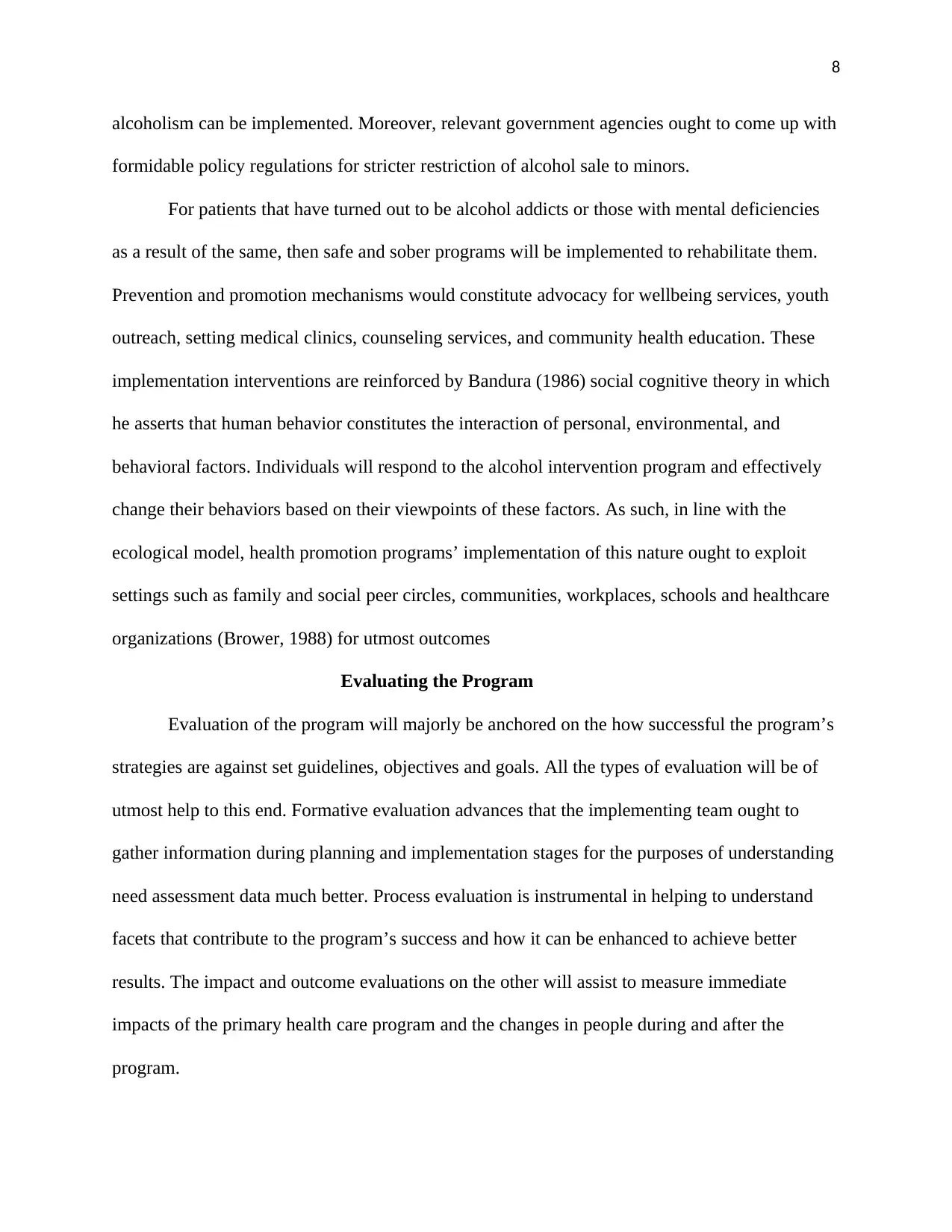
8
alcoholism can be implemented. Moreover, relevant government agencies ought to come up with
formidable policy regulations for stricter restriction of alcohol sale to minors.
For patients that have turned out to be alcohol addicts or those with mental deficiencies
as a result of the same, then safe and sober programs will be implemented to rehabilitate them.
Prevention and promotion mechanisms would constitute advocacy for wellbeing services, youth
outreach, setting medical clinics, counseling services, and community health education. These
implementation interventions are reinforced by Bandura (1986) social cognitive theory in which
he asserts that human behavior constitutes the interaction of personal, environmental, and
behavioral factors. Individuals will respond to the alcohol intervention program and effectively
change their behaviors based on their viewpoints of these factors. As such, in line with the
ecological model, health promotion programs’ implementation of this nature ought to exploit
settings such as family and social peer circles, communities, workplaces, schools and healthcare
organizations (Brower, 1988) for utmost outcomes
Evaluating the Program
Evaluation of the program will majorly be anchored on the how successful the program’s
strategies are against set guidelines, objectives and goals. All the types of evaluation will be of
utmost help to this end. Formative evaluation advances that the implementing team ought to
gather information during planning and implementation stages for the purposes of understanding
need assessment data much better. Process evaluation is instrumental in helping to understand
facets that contribute to the program’s success and how it can be enhanced to achieve better
results. The impact and outcome evaluations on the other will assist to measure immediate
impacts of the primary health care program and the changes in people during and after the
program.
alcoholism can be implemented. Moreover, relevant government agencies ought to come up with
formidable policy regulations for stricter restriction of alcohol sale to minors.
For patients that have turned out to be alcohol addicts or those with mental deficiencies
as a result of the same, then safe and sober programs will be implemented to rehabilitate them.
Prevention and promotion mechanisms would constitute advocacy for wellbeing services, youth
outreach, setting medical clinics, counseling services, and community health education. These
implementation interventions are reinforced by Bandura (1986) social cognitive theory in which
he asserts that human behavior constitutes the interaction of personal, environmental, and
behavioral factors. Individuals will respond to the alcohol intervention program and effectively
change their behaviors based on their viewpoints of these factors. As such, in line with the
ecological model, health promotion programs’ implementation of this nature ought to exploit
settings such as family and social peer circles, communities, workplaces, schools and healthcare
organizations (Brower, 1988) for utmost outcomes
Evaluating the Program
Evaluation of the program will majorly be anchored on the how successful the program’s
strategies are against set guidelines, objectives and goals. All the types of evaluation will be of
utmost help to this end. Formative evaluation advances that the implementing team ought to
gather information during planning and implementation stages for the purposes of understanding
need assessment data much better. Process evaluation is instrumental in helping to understand
facets that contribute to the program’s success and how it can be enhanced to achieve better
results. The impact and outcome evaluations on the other will assist to measure immediate
impacts of the primary health care program and the changes in people during and after the
program.
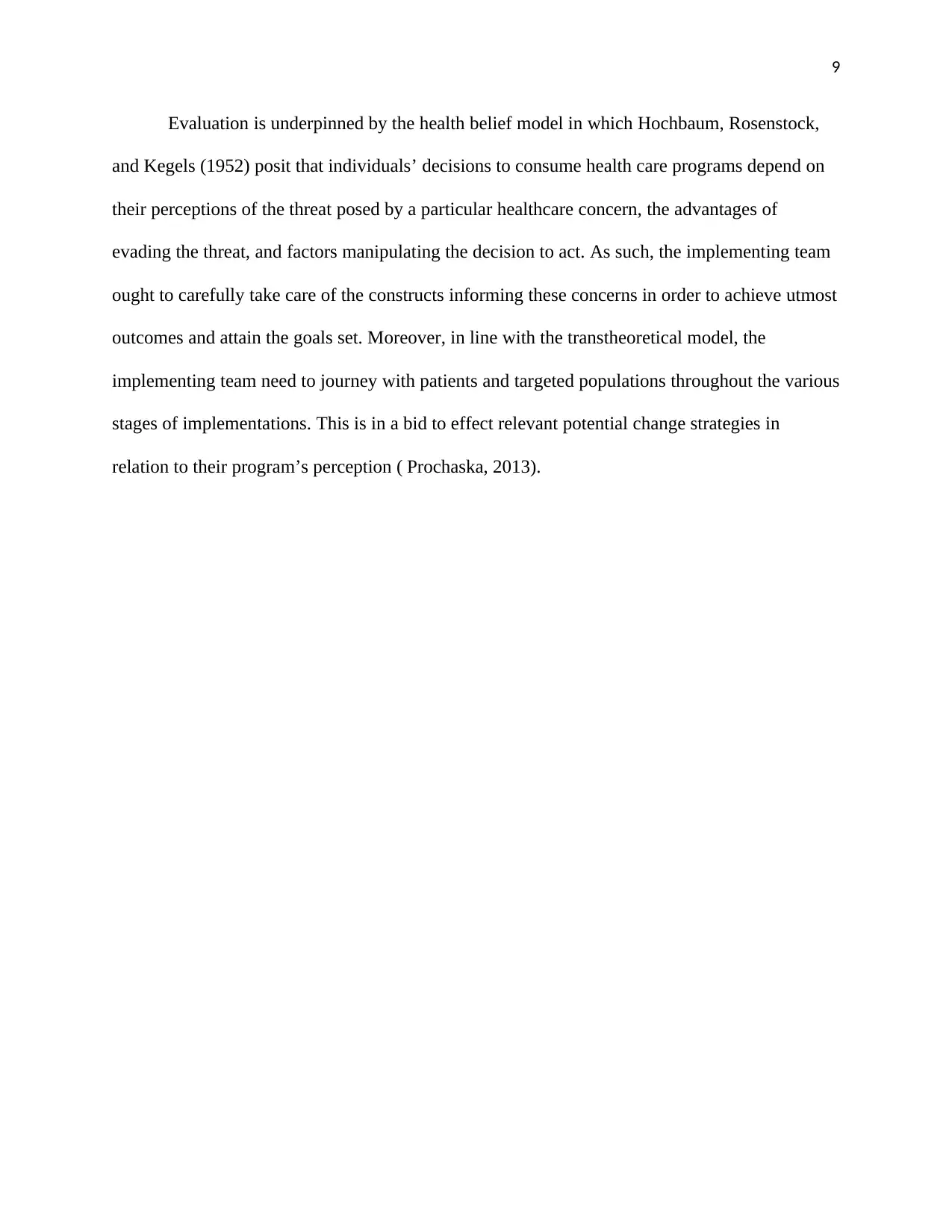
9
Evaluation is underpinned by the health belief model in which Hochbaum, Rosenstock,
and Kegels (1952) posit that individuals’ decisions to consume health care programs depend on
their perceptions of the threat posed by a particular healthcare concern, the advantages of
evading the threat, and factors manipulating the decision to act. As such, the implementing team
ought to carefully take care of the constructs informing these concerns in order to achieve utmost
outcomes and attain the goals set. Moreover, in line with the transtheoretical model, the
implementing team need to journey with patients and targeted populations throughout the various
stages of implementations. This is in a bid to effect relevant potential change strategies in
relation to their program’s perception ( Prochaska, 2013).
Evaluation is underpinned by the health belief model in which Hochbaum, Rosenstock,
and Kegels (1952) posit that individuals’ decisions to consume health care programs depend on
their perceptions of the threat posed by a particular healthcare concern, the advantages of
evading the threat, and factors manipulating the decision to act. As such, the implementing team
ought to carefully take care of the constructs informing these concerns in order to achieve utmost
outcomes and attain the goals set. Moreover, in line with the transtheoretical model, the
implementing team need to journey with patients and targeted populations throughout the various
stages of implementations. This is in a bid to effect relevant potential change strategies in
relation to their program’s perception ( Prochaska, 2013).
⊘ This is a preview!⊘
Do you want full access?
Subscribe today to unlock all pages.

Trusted by 1+ million students worldwide
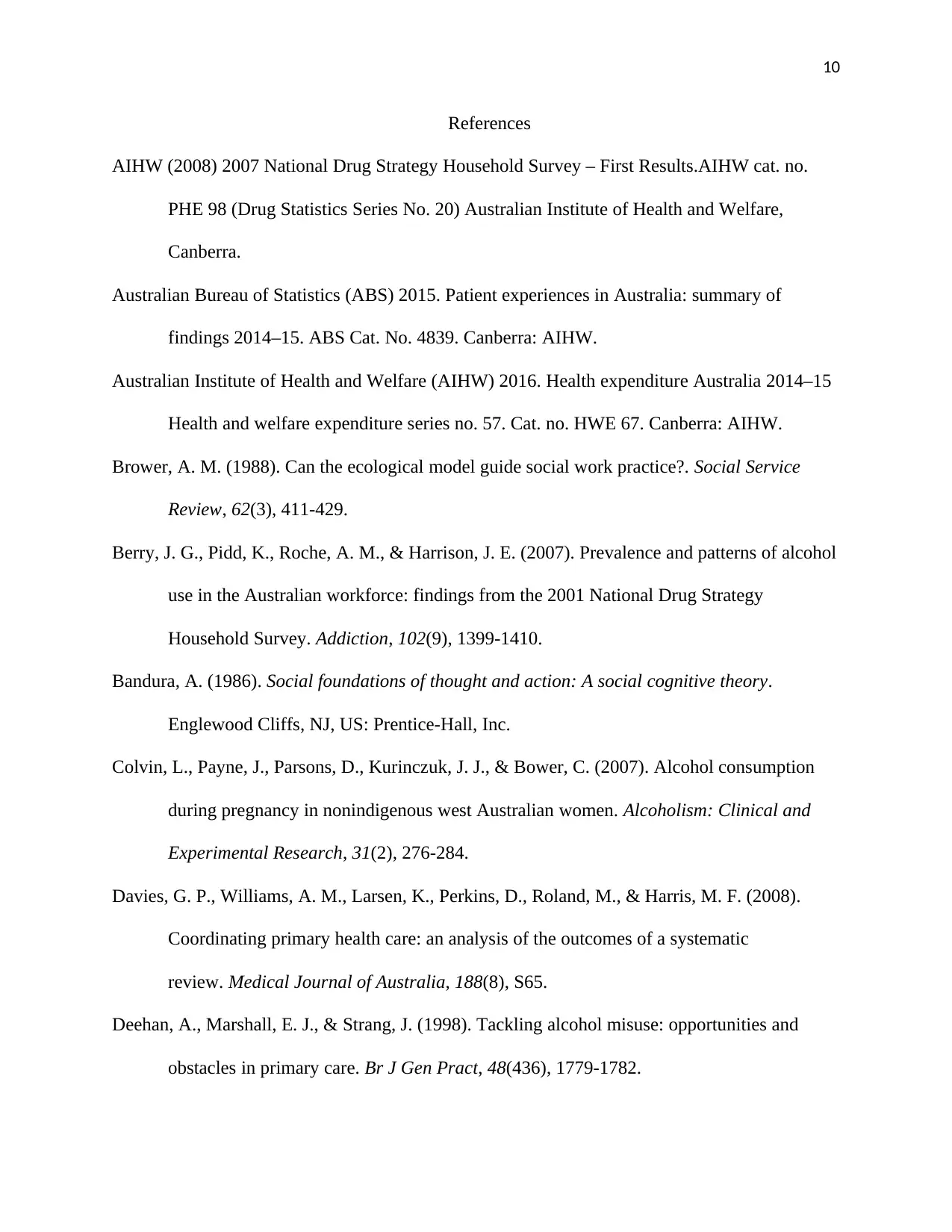
10
References
AIHW (2008) 2007 National Drug Strategy Household Survey – First Results.AIHW cat. no.
PHE 98 (Drug Statistics Series No. 20) Australian Institute of Health and Welfare,
Canberra.
Australian Bureau of Statistics (ABS) 2015. Patient experiences in Australia: summary of
findings 2014–15. ABS Cat. No. 4839. Canberra: AIHW.
Australian Institute of Health and Welfare (AIHW) 2016. Health expenditure Australia 2014–15
Health and welfare expenditure series no. 57. Cat. no. HWE 67. Canberra: AIHW.
Brower, A. M. (1988). Can the ecological model guide social work practice?. Social Service
Review, 62(3), 411-429.
Berry, J. G., Pidd, K., Roche, A. M., & Harrison, J. E. (2007). Prevalence and patterns of alcohol
use in the Australian workforce: findings from the 2001 National Drug Strategy
Household Survey. Addiction, 102(9), 1399-1410.
Bandura, A. (1986). Social foundations of thought and action: A social cognitive theory.
Englewood Cliffs, NJ, US: Prentice-Hall, Inc.
Colvin, L., Payne, J., Parsons, D., Kurinczuk, J. J., & Bower, C. (2007). Alcohol consumption
during pregnancy in nonindigenous west Australian women. Alcoholism: Clinical and
Experimental Research, 31(2), 276-284.
Davies, G. P., Williams, A. M., Larsen, K., Perkins, D., Roland, M., & Harris, M. F. (2008).
Coordinating primary health care: an analysis of the outcomes of a systematic
review. Medical Journal of Australia, 188(8), S65.
Deehan, A., Marshall, E. J., & Strang, J. (1998). Tackling alcohol misuse: opportunities and
obstacles in primary care. Br J Gen Pract, 48(436), 1779-1782.
References
AIHW (2008) 2007 National Drug Strategy Household Survey – First Results.AIHW cat. no.
PHE 98 (Drug Statistics Series No. 20) Australian Institute of Health and Welfare,
Canberra.
Australian Bureau of Statistics (ABS) 2015. Patient experiences in Australia: summary of
findings 2014–15. ABS Cat. No. 4839. Canberra: AIHW.
Australian Institute of Health and Welfare (AIHW) 2016. Health expenditure Australia 2014–15
Health and welfare expenditure series no. 57. Cat. no. HWE 67. Canberra: AIHW.
Brower, A. M. (1988). Can the ecological model guide social work practice?. Social Service
Review, 62(3), 411-429.
Berry, J. G., Pidd, K., Roche, A. M., & Harrison, J. E. (2007). Prevalence and patterns of alcohol
use in the Australian workforce: findings from the 2001 National Drug Strategy
Household Survey. Addiction, 102(9), 1399-1410.
Bandura, A. (1986). Social foundations of thought and action: A social cognitive theory.
Englewood Cliffs, NJ, US: Prentice-Hall, Inc.
Colvin, L., Payne, J., Parsons, D., Kurinczuk, J. J., & Bower, C. (2007). Alcohol consumption
during pregnancy in nonindigenous west Australian women. Alcoholism: Clinical and
Experimental Research, 31(2), 276-284.
Davies, G. P., Williams, A. M., Larsen, K., Perkins, D., Roland, M., & Harris, M. F. (2008).
Coordinating primary health care: an analysis of the outcomes of a systematic
review. Medical Journal of Australia, 188(8), S65.
Deehan, A., Marshall, E. J., & Strang, J. (1998). Tackling alcohol misuse: opportunities and
obstacles in primary care. Br J Gen Pract, 48(436), 1779-1782.
Paraphrase This Document
Need a fresh take? Get an instant paraphrase of this document with our AI Paraphraser
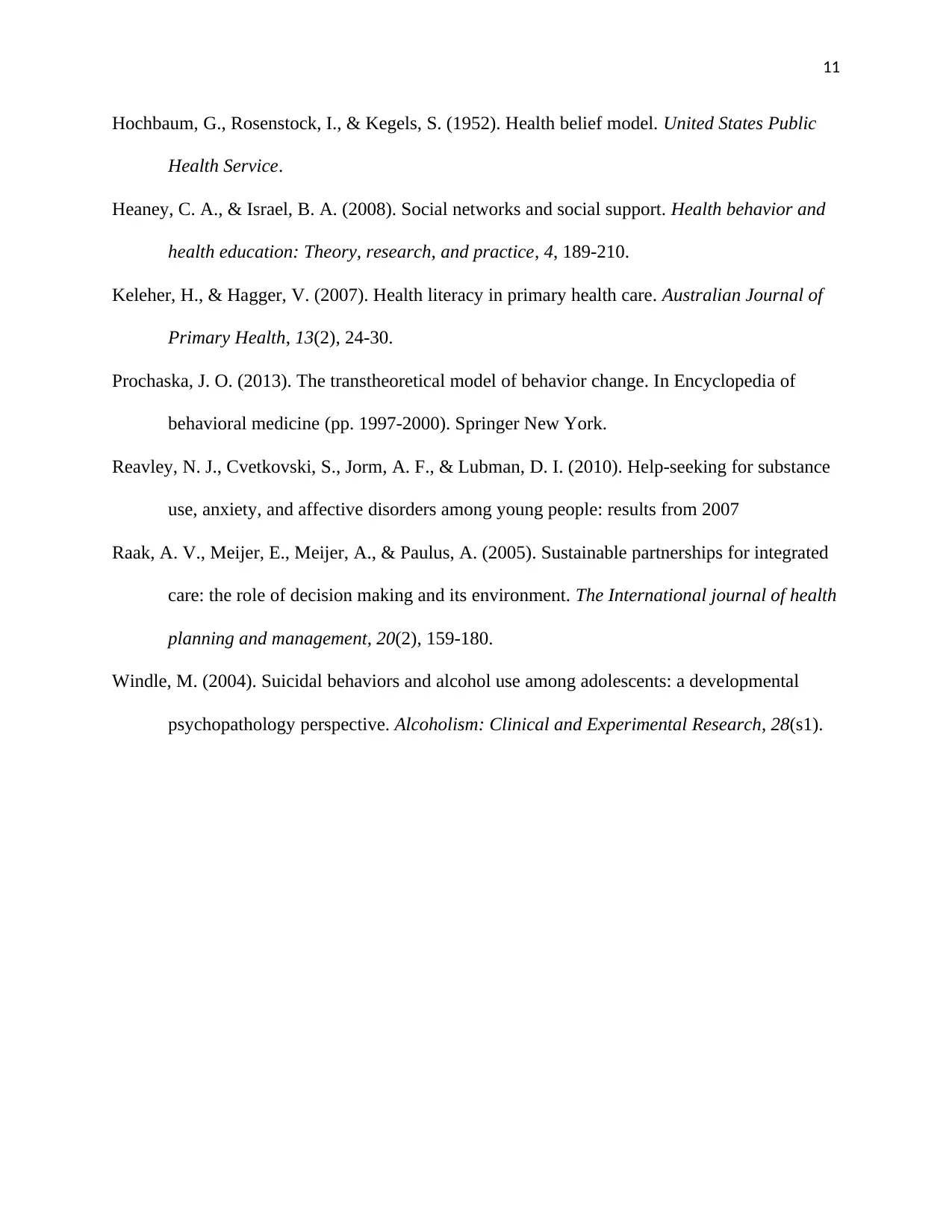
11
Hochbaum, G., Rosenstock, I., & Kegels, S. (1952). Health belief model. United States Public
Health Service.
Heaney, C. A., & Israel, B. A. (2008). Social networks and social support. Health behavior and
health education: Theory, research, and practice, 4, 189-210.
Keleher, H., & Hagger, V. (2007). Health literacy in primary health care. Australian Journal of
Primary Health, 13(2), 24-30.
Prochaska, J. O. (2013). The transtheoretical model of behavior change. In Encyclopedia of
behavioral medicine (pp. 1997-2000). Springer New York.
Reavley, N. J., Cvetkovski, S., Jorm, A. F., & Lubman, D. I. (2010). Help-seeking for substance
use, anxiety, and affective disorders among young people: results from 2007
Raak, A. V., Meijer, E., Meijer, A., & Paulus, A. (2005). Sustainable partnerships for integrated
care: the role of decision making and its environment. The International journal of health
planning and management, 20(2), 159-180.
Windle, M. (2004). Suicidal behaviors and alcohol use among adolescents: a developmental
psychopathology perspective. Alcoholism: Clinical and Experimental Research, 28(s1).
Hochbaum, G., Rosenstock, I., & Kegels, S. (1952). Health belief model. United States Public
Health Service.
Heaney, C. A., & Israel, B. A. (2008). Social networks and social support. Health behavior and
health education: Theory, research, and practice, 4, 189-210.
Keleher, H., & Hagger, V. (2007). Health literacy in primary health care. Australian Journal of
Primary Health, 13(2), 24-30.
Prochaska, J. O. (2013). The transtheoretical model of behavior change. In Encyclopedia of
behavioral medicine (pp. 1997-2000). Springer New York.
Reavley, N. J., Cvetkovski, S., Jorm, A. F., & Lubman, D. I. (2010). Help-seeking for substance
use, anxiety, and affective disorders among young people: results from 2007
Raak, A. V., Meijer, E., Meijer, A., & Paulus, A. (2005). Sustainable partnerships for integrated
care: the role of decision making and its environment. The International journal of health
planning and management, 20(2), 159-180.
Windle, M. (2004). Suicidal behaviors and alcohol use among adolescents: a developmental
psychopathology perspective. Alcoholism: Clinical and Experimental Research, 28(s1).
1 out of 11
Related Documents
Your All-in-One AI-Powered Toolkit for Academic Success.
+13062052269
info@desklib.com
Available 24*7 on WhatsApp / Email
![[object Object]](/_next/static/media/star-bottom.7253800d.svg)
Unlock your academic potential
Copyright © 2020–2025 A2Z Services. All Rights Reserved. Developed and managed by ZUCOL.




